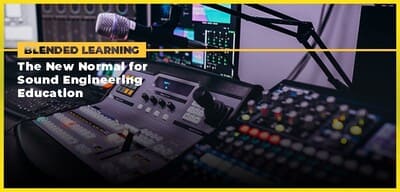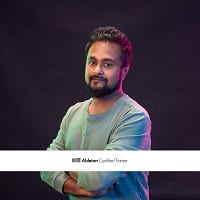Blended Learning – The New Normal for Sound Engineering Education
The deliberation around how we can make education and the learning experience seamless and better for students has led to a wide range of innovations in the media education space. The impact of COVID-19 has been felt across industries, and education has been among the first few domains to really latch on to the potential of technology to deal with the situation.
Transforming the traditional classroom learning model to one that blends this with virtual learning, the rising popularity of the concept of blended learning is no surprise.


Understanding the Idea of Blended Learning
The concept of blended learning has been around for quite some time now, especially in the corporate sector. By leveraging the power of technology and novel learning styles, training is delivered via a mix of offline and online activities. Blended learning was predominantly used by organizations to train their employees across geographies, enabling quick and efficient knowledge acquisition and retention. Today, the pandemic and the lockdowns have made it almost impossible for educational institutes to deliver training the traditional way. Hence, you see more and more schools and colleges moving towards a blended learning approach.
Benefits of Blended Learning for Sound Engineering Education
Sound engineering combines the art and science of creating or modifying sound for a variety of purposes, including film, television, music, web videos, concerts, etc. At Seamedu School of Pro-Expressionism, we have introduced the concept of Seamless Blended Learning, which takes a unique approach to fit the learning styles, interests, preferences, and expectations of students.
Using this combination of traditional instruction and online learning, we have developed a training methodology for our sound engineering courses that enable students to complete their education from anywhere and at any time.
Some of the key benefits of adopting the blended learning approach for sound engineering include:
- Convenience and flexibility: The fact that virtual training can be accessed easily from anywhere and at any time makes this approach extremely elastic and convenient for both, the learner as well as the instructors.
- Synchronous and asynchronous learning: While some modules or activities may involve group participation online, the other parts of the curriculum are delivered in such a way that the students can learn concepts and theories individually.
- Cost: Since online learning requires minimal setup (a laptop and a good internet connection are enough), the cost of learning goes down substantially.
- Reach: Virtual learning has no boundaries, quite literally. Since training is imparted via online lessons or modules, the reach of this model is expansive. Students and instructors based in any corner of the world can gain easy access to each other.
- Participation: Whether it is a one-on-one lesson or a group activity, the blended learning approach encourages enhanced participation from the students. Since the onus of learning is on the learner, this model helps students build self-discipline and motivate themselves to be engaged and involved.
- Best of both worlds: While online learning alone might not be sufficient to learn the nuances of a complex subject like sound engineering, the blended model complements it with ample practical assignments and on-campus time, so that the students get the best of both worlds.
Seamless Blended Learning takes a holistic approach to sound engineering education, integrating in-person classroom training, projects, and virtual learning. Designed to improve engagement and make the learning experience better, this model uses immersive, collaborative, and interactive learning platforms to help our sound engineering students absorb all the essential modules in our curriculum.
LEARNMORE ABOUT SEAMLESS BLENDED LEARNING HERE
We offer our professional sound engineering degree programs in Pune, Bengaluru, and Chandigarh. Wish to know more about the subjects and software we cover under these courses? Visit the following links to understand the curriculum and scope:
Degree in Sound and Music Technology (Pune)
Degree in Sound Engineering (Bengaluru)
Degree in Sound Engineering (Chandigarh)
All three courses are geared towards helping students enter the ever-evolving field of sound engineering as competent professionals with a good understanding of the theoretical as well as practical aspects of the subject. Seamedu is doing everything in its ability to make these courses as accessible to students as possible, using its Seamless Blended Learning model.
Whether this blended learning approach for sound engineering will become the standard in the future is something that we will have to wait and watch. However, until things get back to normal, this is the new normal!
In the meanwhile, explore this comprehensive career guide on how you can build a successful career in sound engineering.


CATEGORIES
Are you aspiring to become a proficient Sound Engineering professional?
Look no further; we are committed to nurturing the potential of young minds. Are you ready to enhance your skills?


